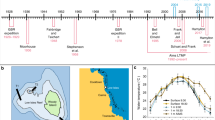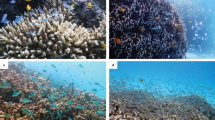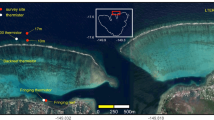Abstract
Different physical and biological processes prevail at different scales1,2,3,4. As a consequence, small-scale experiments or local observations provide limited insights into regional or global phenomena5,6,7,8. One solution is to incorporate spatial scale explicitly into the experimental and sampling design of field studies, to provide a broader, landscape view of ecology1,2,3,4,5,6,7,8. Here we examine spatial patterns in corals on the Great Barrier Reef, across a spectrum of scales ranging from metres to more than 1,700 km. Our study is unusual because we explore large-scale patterns of a process (recruitment by juveniles) as well as patterns of adult abundance, revealing the relationship between the two. We show that coral-reef assemblages that are similar in terms of abundance may nonetheless show profound differences in dynamics and turnover, with major implications for their ecology, evolution and management.
This is a preview of subscription content, access via your institution
Access options
Subscribe to this journal
Receive 51 print issues and online access
$199.00 per year
only $3.90 per issue
Buy this article
- Purchase on Springer Link
- Instant access to full article PDF
Prices may be subject to local taxes which are calculated during checkout





Similar content being viewed by others
References
Kareiva, P. & Andersen, M. in Lecture Notes in Biomathematics: Community Ecology (ed. Hastings, A.) 38–45 (Springer, Berlin, (1988).
Wiens, J. A. Spatial scaling in ecology. Func. Ecol. 3, 385–397 (1989).
Jackson, J. B. C. Adaptation and diversity of reef corals. Bioscience 41, 475–482 (1991).
Schneider, D. C. Quantitative Ecology: Spatial and Temporal Scaling (Academic, San Diego, (1994).
Ricklefs, R. E. Community diversity: relative roles of local and regional processes. Science 235, 167–171 ( 1987).
Levin, S. The problem of pattern and scale in ecology. Ecology 73, 1943–1967 (1992).
Ricklefs, R. E. & Schluter, D. (eds) Species Diversity in Ecological Communities (Univ. Chicago Press, ( 1993).
Eberhardt, L. L. & Thomas, J. M. Designing environmental field studies. Ecol. Monogr. 61, 53– 73 (1991).
Harrison, P. L. & Wallace, C. C. in Ecosystems of the World (ed. Dubinsky, Z.) 133–207 (Elsevier, New York, (1990).
Searle, S. R., Casella, G. & McCulloch, C. E. Variance Components (Wiley Interscience, New York, (1992).
Harrison, P. L. et al. Mass-spawning in tropical reef corals. Science 223, 1186–1189 ( 1984).
Ayre, D. J. & Dufty, S. L. Restricted gene flow in the viviparous coral Seriatopora hystrix on Australia's Great Barrier Reef. Evolution 48, 1183–1201 (1994).
Benzie, J. A. H., Haskell, A. & Lehman, H. Variation in the genetic composition of coral (Pocillopora damicornis and Acropora palifera) populations from different reef habitats. Mar. Biol. 121, 731– 739 (1995).
Ayre, D. J., Hughes, T. P. & Standish, R. J. Genetic differentiation, reproductive mode, and gene flow in the brooding coral Pocillopora damicornis along the Great Barrier Reef, Australia. Mar. Ecol. Prog. Ser. 159, 175–187 (1997).
Sale, P. F., Doherty, P. J., Eckhert, G. J., Douglas, W. A. & Ferrell, D. J. Large scale spatial and temporal variation in recruitment of fish populations on coral reefs. Oecologia 64, 191–198 ( 1984).
Doherty, P. J. & Williams, D. McB. The replenishment of coral reef fish populations. Oceanogr. Mar. Biol. Annu. Rev. 26, 487–551 ( 1988).
Rogers, C. R., Fitz, H. C., Gilnack, M., Beets, J. & Hardin, J. Scleractinian coral recruitment patterns at Salt River submarine canyon, St. Croix, U.S. Virgin Islands. Coral Reefs 3, 69–76 (1984).
Richmond, R. H. & Hunter, C. L. Reproduction and recruitment of corals: comparisons among the Caribbean, the tropical Pacific, and the Red Sea. Mar. Ecol. Prog. Ser. 60, 185–203 (1990).
Smith, S. R. Patterns of coral recruitment and post-settlement mortality on Bermuda's reefs: comparisons to Caribbean and Pacific reefs. Am. Zool. 32, 663–673 (1992).
Sweatman, H. P. A. The influence of adults of some reef fishes on larval recruitment. Ecol. Monogr. 55, 469–485 (1985).
Caley, M. J. Reef-fish community structure and dynamics: an interaction between local and larger-scale processes? Mar. Ecol. Prog. Ser. 129, 19–29 (1995).
Connell, J. H. in Biology and Geology of Coral Reefs, Vol. 1 (eds Jones, O. A.&Endean, R. E.) 205–245 (Academic, New York, (1973).
Connell, J. H., Hughes, T. P. & Wallace, C. D. A30-year study of coral community dynamics: influence of disturbance and recruitment on abundance, at several scales in space and time. Ecol. Monogr. 67, 461– 488 (1997).
Hughes, T. P. Demographic approaches to community dynamics: a coral reef example. Ecology 77, 2256–2260 ( 1996).
Kojis, B. in Proc. Colloquium on Global Aspects of Coral Reefs: Health, Hazards, History (ed. R. N. Ginsburg) P35–P41 (Univ. Miami, Florida, (1993).
Connell, J. H. Disturbance and recovery of coral assemblages. Coral Reefs 16(Suppl.), 101–113 (1997 ).
Acknowledgements
We thank the 41 graduate-student volunteers from James Cook University (JCU) who provided field assistance, and D. Ayre, J. Caley, P. Doherty and L. Smith for comments on the manuscript. Research was funded by grants to T.P.H. from the Australian Research Council. This is contribution no. 162 of the Coral Group at JCU.
Author information
Authors and Affiliations
Corresponding author
Rights and permissions
About this article
Cite this article
Hughes, T., Baird, A., Dinsdale, E. et al. Patterns of recruitment and abundance of corals along the Great Barrier Reef. Nature 397, 59–63 (1999). https://doi.org/10.1038/16237
Received:
Accepted:
Issue Date:
DOI: https://doi.org/10.1038/16237
This article is cited by
-
Studying functions on coral reefs: past perspectives, current conundrums, and future potential
Coral Reefs (2024)
-
Local human impacts disrupt depth-dependent zonation of tropical reef fish communities
Nature Ecology & Evolution (2023)
-
Seasonal trends in benthic macrofauna communities and their relationship with environmental factors in an Atlantic lagoonal system
Biologia (2022)
-
Spatio-temporal persistence of scleractinian coral species at Lizard Island, Great Barrier Reef
Coral Reefs (2021)
-
Trophic downgrading reduces spatial variability on rocky reefs
Scientific Reports (2020)
Comments
By submitting a comment you agree to abide by our Terms and Community Guidelines. If you find something abusive or that does not comply with our terms or guidelines please flag it as inappropriate.



